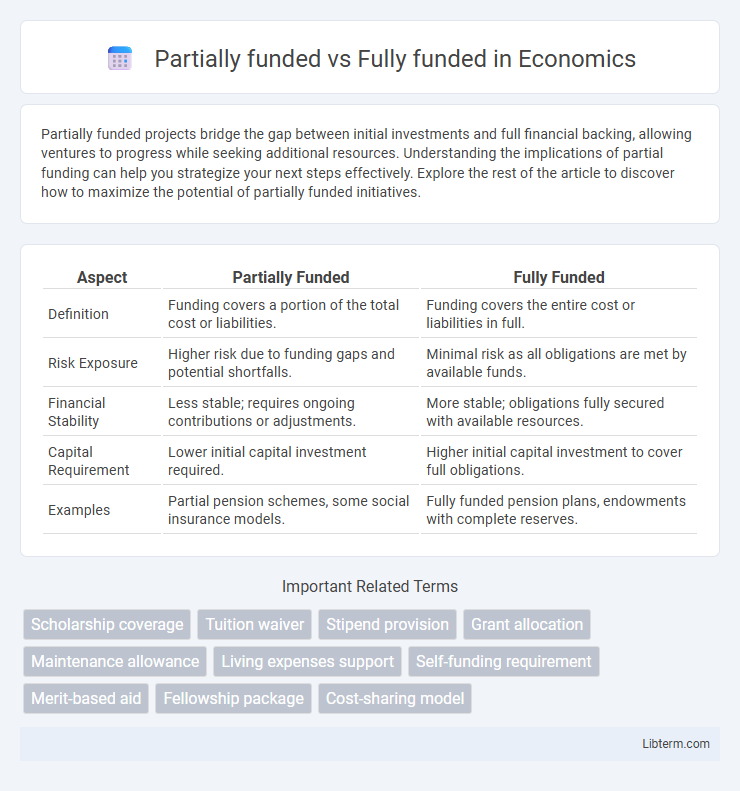Partially funded projects bridge the gap between initial investments and full financial backing, allowing ventures to progress while seeking additional resources. Understanding the implications of partial funding can help you strategize your next steps effectively. Explore the rest of the article to discover how to maximize the potential of partially funded initiatives.
Table of Comparison
| Aspect | Partially Funded | Fully Funded |
|---|---|---|
| Definition | Funding covers a portion of the total cost or liabilities. | Funding covers the entire cost or liabilities in full. |
| Risk Exposure | Higher risk due to funding gaps and potential shortfalls. | Minimal risk as all obligations are met by available funds. |
| Financial Stability | Less stable; requires ongoing contributions or adjustments. | More stable; obligations fully secured with available resources. |
| Capital Requirement | Lower initial capital investment required. | Higher initial capital investment to cover full obligations. |
| Examples | Partial pension schemes, some social insurance models. | Fully funded pension plans, endowments with complete reserves. |
Understanding Funding: Partial vs Full
Understanding funding requires distinguishing between partially funded projects, where only a portion of the total costs is covered, and fully funded projects, which have all expenses completely financed. Partial funding often necessitates additional resources, such as loans or out-of-pocket expenses, risking budget shortfalls, while full funding ensures uninterrupted project execution and financial stability. Funding strategies impact project scope, timeline, and risk management, making it essential to evaluate the extent of financial support before project initiation.
Key Differences Between Partially Funded and Fully Funded
Partially funded projects receive some but not all necessary financial resources, requiring supplementary funding sources or cost adjustments, while fully funded projects secure complete financial backing from the outset, ensuring smooth execution without financial interruptions. The key difference lies in risk management; partially funded initiatives face higher financial uncertainty and potential delays, whereas fully funded projects benefit from guaranteed capital, facilitating better planning and resource allocation. Budget control and project scope are directly impacted as partially funded projects may limit scope or delay phases, in contrast to fully funded projects that maintain original timelines and deliverables with confidence.
Eligibility Criteria for Funding Types
Eligibility criteria for partially funded programs typically require applicants to demonstrate financial need alongside meeting specific academic or professional qualifications, allowing for shared cost coverage. Fully funded opportunities demand stricter eligibility, often targeting high-achieving candidates, leaders in their fields, or individuals from underrepresented backgrounds, with comprehensive support including tuition, living expenses, and travel. Verification of eligibility documents, such as academic transcripts, financial statements, and recommendation letters, is essential for both funding types, but fully funded options usually involve a more rigorous selection process.
Financial Coverage: What’s Included?
Partially funded programs typically cover specific expenses such as tuition fees or accommodation, leaving students responsible for other costs like travel, personal expenses, and study materials. Fully funded programs provide comprehensive financial coverage, including tuition, accommodation, travel allowances, insurance, and sometimes living stipends. Understanding the extent of coverage helps applicants assess the actual financial support available and plan for any additional funding needs.
Benefits of Fully Funded Opportunities
Fully funded opportunities cover tuition, accommodation, and living expenses, removing financial barriers and allowing recipients to focus entirely on their academic and professional development. These scholarships often include health insurance, travel allowances, and access to exclusive networking events, enhancing the overall experience and career prospects. Recipients benefit from reduced stress and greater access to resources, increasing their chances of academic success and personal growth.
Limitations of Partially Funded Programs
Partially funded programs often face significant budget constraints that limit their ability to cover all necessary expenses, causing gaps in resources and support. These programs may restrict participant eligibility or reduce the scope of services offered, resulting in uneven access and outcomes. Funding variability can lead to unstable program operations and hinder long-term planning and impact.
Application Process: Tips for Success
Understanding the distinction between partially funded and fully funded scholarships can significantly impact your application strategy; fully funded programs often require extensive documentation and proof of academic excellence, while partially funded ones may prioritize specific criteria such as community involvement or leadership skills. Tailoring your personal statement to highlight the values and goals of the funding institution increases your chances of success. Meticulously following application guidelines and submitting all required materials on time are critical steps regardless of funding type.
Real-life Examples: Partial vs Full Funding
Partially funded projects, such as Kickstarter campaigns that secure only a portion of their target amount, often lead to scaled-back deliverables or extended timelines, as seen in Pebble Technology's initial smartwatch launch. Fully funded initiatives, like the Oculus Rift Kickstarter campaign which raised over $2.4 million, typically have the resources to meet original project goals and timelines, enabling smoother product development and delivery. Platforms like Indiegogo and GoFundMe demonstrate the stark contrast in outcomes between partial and full funding in real-world crowdfunding campaigns.
Which Funding Option is Right for You?
Choosing between partially funded and fully funded opportunities depends on your financial needs and commitment level. Fully funded programs cover all expenses, including tuition, accommodation, and sometimes living costs, ideal for those seeking comprehensive support without financial strain. Partially funded options require supplementary funding but offer flexibility and often cover significant costs such as tuition or research expenses, making them suitable for individuals who can manage some out-of-pocket expenses.
Common Myths About Funding Types
Common myths about funding types include the belief that fully funded opportunities cover every expense without exceptions, while partially funded options always require significant out-of-pocket costs. Many assume partially funded programs provide minimal financial support, yet they often cover key expenses like tuition or accommodation, making them more accessible than perceived. Misunderstandings about eligibility and obligations for fully funded scholarships also persist, with some thinking these awards come without academic or service commitments.
Partially funded Infographic

 libterm.com
libterm.com